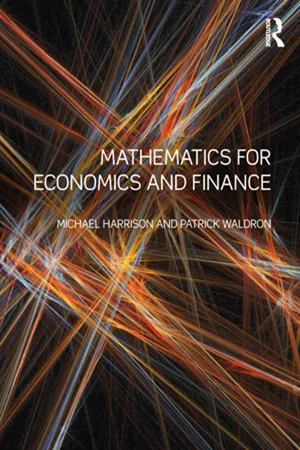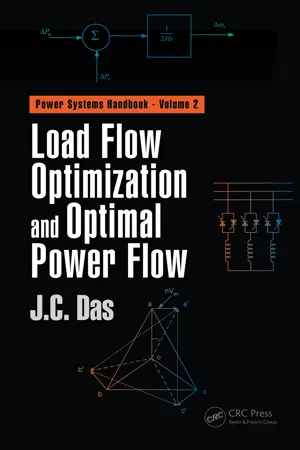Convexity and Concavity
Convexity and concavity refer to the shape of a curve or function. A function is convex if the line segment between any two points on the graph lies above the graph, while a function is concave if the line segment lies below the graph. In mathematical terms, convexity is associated with non-decreasing second derivatives, while concavity is associated with non-increasing second derivatives.
4 Key excerpts on "Convexity and Concavity"
- eBook - ePub
- Michael Harrison, Patrick Waldron(Authors)
- 2011(Publication Date)
- Routledge(Publisher)
...Roughly speaking, a function of n variables is convex if the set above its graph is a convex subset of ℝ n +1 and concave if the set below its graph is a convex subset of ℝ n +1. From this rough description, it should already be clear that the concepts of concave and convex functions are broadly analogous. It is important to bear in mind, however, that there is no such thing as a concave set. For this reason, this branch of mathematics is usually described as convexity and never as concavity. Thus only the word “convexity” appears in the titles of this chapter and of various sections below. We can approach the characterization of convex and concave functions of several variables from three perspectives. The formal definitions are in terms of the restrictions of the function in question to line segments in its domain. The other characterizations apply only to those convex and concave functions that are appropriately differentiable. The second characterization is based on properties of the first derivative of the function (see Theorem 10.2.4) and the third characterization is based on properties of the second derivative or Hessian (see Theorem 10.2.5). Definition 10.2.1 Let f : X → Y, where X is a convex subset of a real vector space and Y ⊆ ℝ. Then f is a concave function if and only if, for all x ≠ x ′ ∈ X and λ ∈ (0, 1), f (λ x + (1 − λ) x ’) ≥ λ f (x) + (1 − λ) f (x ’) (10.1) The reader should note a number of important points concerning Definitions 7.3.4 and 10.2.1. The function f is convex if and only if – f is concave. Since every convex function is the mirror image of a concave function, and vice versa, every result derived for one has an obvious corollary for the other...
- eBook - ePub
Engineering Optimization
Theory and Practice
- Singiresu S. Rao(Author)
- 2019(Publication Date)
- Wiley(Publisher)
...Appendix A Convex and Concave Functions Convex Function A function f (X) is said to be convex if for any pair of points and all λ, 0 ≤ λ ≤ 1, (A.1) that is, if the segment joining the two points lies entirely above or on the graph of f (X). Figures A.1 a and A.2 a illustrate a convex function in one and two dimensions, respectively. It can be seen that a convex function is always bending upward and hence it is apparent that the local minimum of a convex function is also a global minimum. Figure A.1 Functions of one variable: (a) convex function in one variable; (b) concave function in one variable. Figure A.2 Functions of two variables: (a) convex function in two variables; (b) concave function in two variables. Concave Function A function f (X) is called a concave function if for any two points X 1 and X 2, and for all 0 ≤ λ ≤ 1, (A.2) that is, if the line segment joining the two points lies entirely below or on the graph of f (X). Figures A.1 b and A.2 b give a concave function in one and two dimensions, respectively. It can be seen that a concave function bends downward and hence the local maximum will also be its global maximum. It can be seen that the negative of a convex function is a concave function, and vice versa. Also note that the sum of convex functions is a convex function and the sum of the concave functions is a concave function. A function f (X) is strictly convex or concave if the strict inequality holds in Eqs. (A.1) or (A.2) for any X 1 ≠ X 2. A linear function will be both convex and concave since it satisfies both inequalities (A.1) and (A.2). A function may be convex within a region and concave elsewhere...
- eBook - ePub
- Craig Friedman, Sven Sandow(Authors)
- 2016(Publication Date)
- Chapman and Hall/CRC(Publisher)
...We shall restrict ourselves to problems defined in R n, outlining some ideas and results and providing some but not all necessary proofs. More detailed expositions can be found in the textbooks by Rockafellar (1970), and Boyd and Vandenberghe (2004). Most of the results we discuss in this section also hold for problems defined in more general linear vector spaces. Although we shall occasionally use these generalizations later in this book, we shall not discuss them in this section, but rather refer the reader to Luenberger (1969). The practical importance and usefulness of convexity of a optimization problem is to a large extent derived from the fact that any local minimum of a convex function on a convex set is also a global minimum. This considerably simplifies the numerical procedures that can be employed to solve these optimization problems. A very useful concept that we shall frequently utilize in this book is the concept of convex duality. Based on this idea, a convex problem can be related to its so-called dual problem, which has, under certain conditions, the same solution as the original problem. In a later chapter, we will use this duality to relate relative entropy minimization to the maximum-likelihood method. 2.2.1 Convex Sets and Convex Functions Definition 2.1 A set S ⊆ R n is called convex if, for any x 1 ∈ S and x 2 ∈ S and any λ ∈ [0, 1], λx 1 + (1 − λ) x 2 ∈ S. Figure 2.6 illustrates this definition. Definition 2.2 A function f : R n → R is called convex if its domain, dom (f), is a convex set and if, for all x x, x 2 ∈ dom (f) and any λ ∈ (0,. 1), f (λ x 1 + (1 - λ) x 2) ≤ λ f (x 1) + (1 - λ) f (x 2). (2.86) If strict inequality holds whenever x 1 ≠ x 2, the function is called strictly convex...
- eBook - ePub
- J. C. Das(Author)
- 2017(Publication Date)
- CRC Press(Publisher)
...Some functions may not be definitely convex or concave. The function f (x) = x 3 in Figure 11.2d is concave in the interval (−∞, 0) and convex in the interval (0, ∞). The convexity plays an important role. If it can be shown that the objective function is convex and the constraint set is convex, then the problem has a unique solution. It is not easy to demonstrate this. The optimal power flow problem (Chapter 12) is generally nonconvex. Therefore, multiple minima may exist which may differ substantially. 11.3 Taylor’s Theorem If f (x) is continuous and has a first derivative, then for any two points x 1 and x 2, where x 2 = x 1 + incremental h, there is θ, 0 ≤ θ ≤ 1, so. that f (x 2) = f (x 1) + h f ′ [ θ x 1 + (1 − θ) x 2 ] (11.7) Extending f (x 2) = f (x 1) + h f ′ (x 1) + h 2 2 ! f ′ (x 1) + ⋯ + h n n ! f (n) [ θ x 1 + (1. − θ) x 2 ] (11.8) A function f (x) has a relative maximum or minimum at x * only if n is even, where n is the order of the first nonvanishing derivative at x *. It is a maximum if f (n) (x*) < 0 and a minimum if f (n) (x*) > 0. Example 11.1 Consider f (x) =(x –. 1) 4 d f (x) d x = 4 (x − 1) 3, d 2 f (x) d x 2 = 12 (x − 1) 2, d 3 f (x) d x 3 = 24 (x − 1), d 4 f (x) d x 4 = 24 The fourth derivative is even, and is the first nonvanishing derivative at x = 1; therefore, x = 1 is the minimum. For a continuous differentiable function, in a small interval, the maximum and minimum can be determined as shown above. These are relative or local, and most of the time, we will be interested in finding the global maxima or minima for a ≤ x ≤ b. A procedure for this is as follows: Compute f(a) and f(b), compute f ′(x), find roots of f ′(x) = 0. If there are no roots in [a, b], then z * is larger of f (a) and f (b)...



